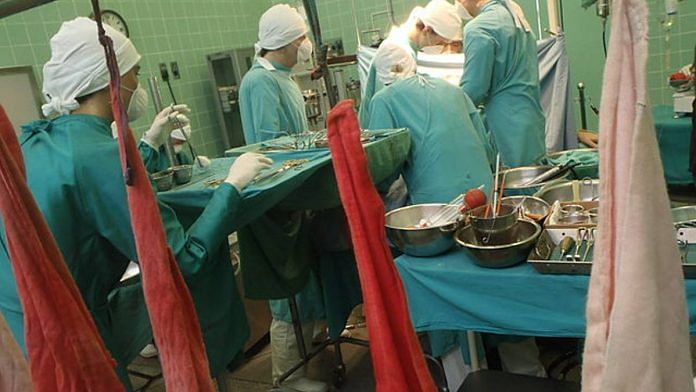New Delhi: Even as the government of India has decided to bring in path-breaking changes to make the system of organ donation more equitable and uniform across the country and promote cadaver donations, inherent gaps in the transplant programme remain despite improvements in the last few years.
The fact that only about one in every four organ transplants in India happen in the government sector indicates that it is a facility still available only to affluent Indians. It is also important to note that only four states — Tamil Nadu, Punjab, Bihar and Maharashtra — have availed the centre’s programme that helps states set up new transplant centres in the public sector.
A senior official in the ministry of health told ThePrint that in the five odd years that the government of India is running a programme to encourage states to set up public sector facilities for organ transplant, only four states have sought the grant.
“Under the programme, we give Rs 1.5 crore for new centres and Rs 75 lakh for upgrading an existing centre or setting up new retrieval centres. But uptake is a little slow, because we do not give grants for manpower. So far we have given money to Tamil Nadu for a transplant centre , Punjab for an organ retrieval centre, Bihar for a transplant and retrieval centre and to Maharastra for a retrieval training centre and biomaterial (tissue bank). The centre has not refused any application till date.” The licence is given by the state-level authorities.
Also Read: Brain dead after injury, 27-year-old Indian Air Force corporal’s organs save lives
Cadaver donations need to improve

Less than one in every five organs transplanted in India come from a deceased donor.
Of the 15,556 organ transplants that happened in India in 2022, only 2,765 organs came from deceased donors despite efforts being made over the years to increase cadaver organ donations. Though the numbers have gone up — from 837 cadaver donations in 2013 to 2,765 in 2022 — lack of awareness and social and religious beliefs remain the biggest impediments in organ donation from brain dead patients who do not have any hopes of revival.
In a move towards one nation one (cadaver organ) waiting list, top health ministry sources Thursday announced that the government has decided to remove the domicile requirement for registration of organ seekers and make the process more equitable. It is also planning to do away with the age cap of 65 years for prospective cadaver organ recipients and the registration fees of Rs 5000-10,000 charged by states.
Although the medical fraternity welcomed the move, they pointed out that the logistical creases in inter-state transport of organs, which have to be shipped in strictly controlled conditions within a very short period of time, need to be ironed out before full implementation of the proposed changes. The government, meanwhile, is working on a plan to use drones to transport cadaver organs from one location to another.
Private sector rules
Worryingly, the transplant programmes remain a forte of the private sector. While the government of India does not have data on what percentage of transplants happen in non government institutions, industry estimates suggest that about three quarters of all transplants in India happen in the private sector.
While heart and lung transplants remain less common and almost exclusively in the private sector, even for the more common surgeries such as kidney and liver transplant, the private sector is way ahead, thanks to dedicated teams, higher investment muscle and a clientele with higher spending power.
The largest kidney transplant centre in the public sector is Chandigarh’s Postgraduate Institute of Medical Education and Research (PGIMER), which does about 200 surgeries per year — a third of the annual output of Delhi’s Indraprastha Apollo Hospital alone.
For liver transplants, of the 2000-2200 surgeries that take place in the country every year, about 250-300 happen at just one private centre in Delhi — Max Superspeciality, Saket.
Demand supply gap

The slow uptake of the cadaver programme is one of the crucial reasons why there is a gaping demand supply gap in organs. According to estimates drawn up by the Directorate General of Health Services, around 1.8 lakh persons suffer from renal failure every year. In 2022 the total number of kidney transplants stood at 11,423 of which 9,834 were from living donors.
DGHS estimates that about 2 lakh patients die of liver failure or liver cancer annually in India. In 2022 the total number of liver transplants that happened in India stood at 3718, of which 2,957 were from living donors. About 50,000 people suffer from heart failure annually. In 2022 just 250 transplants happened in the country.
A senior liver transplant surgeon from Max Super Speciality Hospital, speaking on conditions of anonymity told ThePrint: “The decision to remove the age cap of 65 years is very good, but the logistics of how this one nation one waiting list will work remains unclear.
Organs remain viable for a very short span of time. Even if the registration is allowed there remains the problem of transporting organs from one city to another. There have been several instances when organs have been flown in from a city to another but that is still an infrequent practice. Systems will have to be put in place for that to happen more regularly. My fear is this, at least in the short term it could end up opening a Pandora’s box. There are now companies that store the organs for some time, but that could raise the cost of the procedure by another Rs 10-12 lakh in India,” he added.
(Edited by Geethalakshmi Ramanathan)
Also Read: Dedicated teams, cost, facilities — why pvt hospitals do over 75% of organ transplants in India



